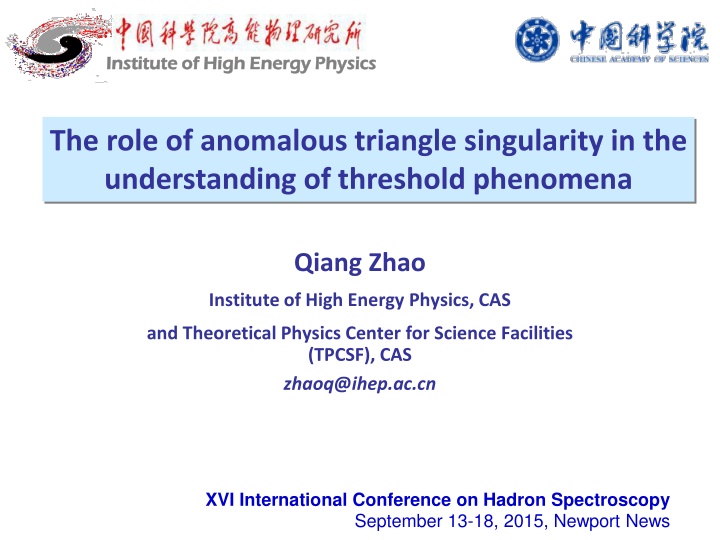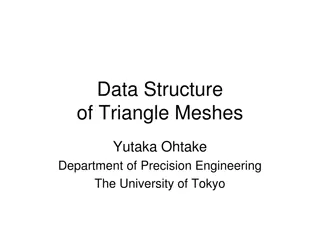Role of Anomalous Triangle Singularity in Threshold Phenomena Understanding
Anomalous Triangle Singularity (ATS) is explored in the context of threshold phenomena understanding, focusing on its occurrence when all three internal particles are simultaneously on shell. The study delves into kinematic effects, genuine states recognition, and specific cases such as heavy pentaquark production at LHCb. The research sheds light on exotic hadrons and new quarkonium-like states, providing insights into non-standard configurations and violations of isospin or heavy quark symmetries.
Download Presentation

Please find below an Image/Link to download the presentation.
The content on the website is provided AS IS for your information and personal use only. It may not be sold, licensed, or shared on other websites without obtaining consent from the author.If you encounter any issues during the download, it is possible that the publisher has removed the file from their server.
You are allowed to download the files provided on this website for personal or commercial use, subject to the condition that they are used lawfully. All files are the property of their respective owners.
The content on the website is provided AS IS for your information and personal use only. It may not be sold, licensed, or shared on other websites without obtaining consent from the author.
E N D
Presentation Transcript
Institute of High Energy Physics Institute of High Energy Physics The role of anomalous triangle singularity in the understanding of threshold phenomena Qiang Zhao Institute of High Energy Physics, CAS and Theoretical Physics Center for Science Facilities (TPCSF), CAS zhaoq@ihep.ac.cn XVI International Conference on Hadron Spectroscopy September 13-18, 2015, Newport News
Outline 1. Motivation: kinematic effects or genuine states? 2. Anomalous triangle singularity 3. Cases to recognize anomalous triangle singularity: Heavy pentaquark production at LHCb 4. Summary
1. Motivation: kinematic effects or genuine states?
Multi-faces of QCD: Exotic hadrons Pentaquark Hybrid Tetraquark Glueball Proton u Hadronic molecule d u d Neutron d u Deuteron: p-n molecule Evidence for QCD exotic states is a missing piece of knowledge about the Nature of strong QCD.
Brief summary of the exp. progress New quarkonium-like states, i.e. X, Y, Z s, are observed in experiment Do not fit in the conventional quarkonium spectrum as quark-antiquark states, e.g. X(3872), Y(4260), X(3900) etc. Most of these new states, such as X(3872), are located close to a two-particle threshold. Evidence for charged quarkonium states, e.g. Zb(10610), Zb(10650) , Zc(3900), Zc(4020), Z(4430), etc. In some cases, isospin or heavy quark symm. are violated. Good candidates for hadronic molecules or other non- standard configurations, e.g. tetraquarks, hybrids, etc. Evidence for heavy pentaquarks, i.e. Pc(4380) and Pc(4430), reported by LHCb.
Anomalous triangle singularity The ATS occurs when all the three internal particles can be simultaneously on shell. It corresponds to for all j=1,2,3. L. D. Landau, Nucl. Phys. 13, 181 (1959). G. Bonnevay, I. J. R. Aitchison and J. S. Dowker, Nuovo Cim. 21, 3569 (1961). 7
Kinematics : The ATS condition for fixed s1, mj, and s3is: Or for fixed s1, mj, and s2: 8 X.-H. Liu and Q. Zhao, arXiv:1507.01674 [hep-ph]
Single dispersion relation in s2: The spectral function (s1, s2, s3) can be obtained by means of the Cutkosky s rules (absorptive part of the loop amplitude) or the formula which reads 9
For fixed s1, s3and mi, the spectral function (s1, s2, s3) has logarithmic branch points s 2, which correspond to the anomalous thresholds by solving the Landau equation. How the logarithmic branch points s 2move as s1increases from the threshold of (m2+ m3)2, with s3and mifixed? Substituting s1 s1+i , s 2in the s -plane are then located at The normal thresholds and critical values for s1and s2as follows, With 10
Trajectory of s2in the complex s2-plane with s1increasing from s1Nto . P: 11
The difference between the normal and anomalous thresholds: When s2=s2N(s1=s1N), we will obtain the maximum value of s1( s2), 12
3. Cases to recognize anomalous triangle singularity: Heavy pentaquark production at LHCb Many other cases: J.-J. Wu, X.-H. Liu, and Q. Zhao, B.-S. Zou, PRL108, 081003 (2012) X.-G. Wu, J.-J. Wu, Q. Zhao, B.-S. Zou, PRD 87, 014023 (2013) Q. Wang, C. Hanhart, Q. Zhao, PRL111, 132003 (2013) Q. Wang, C. Hanhart, Q. Zhao, PLB725, 106 (2013) X.-H. Liu, Q. Zhao, arXiv:1507.01674 [hep-ph] A. P. Szczepaniak, PLB747, 410 (2015) [arXiv:1501.01691 [hep-ph]] M.Mikhasenko, B. Ketzer and A. Sarantsev, PRD 094015 (2015) [arXiv:1501.07023 [hep-ph]]
arXiv:1507.03414v2 [hep-ex], PRL(2015) Pc+ +(4380) Pc+ +(4450) 14
Data analysis including * and pentaquark states M[Pc+ +(4380)] = (4380 8 29) MeV, = (205 18 86) MeV M[Pc+ +(4450)] = (4449.8 1.7 2.5) MeV, =(39 5 19) MeV JP= (3/2 , 5/2+ +) or (3/2+ +, 5/2 ) 15
Immediate theoretical studies: 1) Molecular states: R. Chen, X. Liu, X.-Q. Li, S.-L. Zhu, arXiv:1507.03704[hep-ph] L. Roca, J. Nieves and E. Oset, arXiv:1507.04249 [hep-ph]. A. Feijoo, V. K. Magas, A. Ramos and E. Oset, arXiv:1507.04640 [hep-ph] J. He, arXiv:1507.05200 [hep-ph] U.-G. Meissner, J.A. Oller, arXiv:1507.07478v1 [hep-ph] 2) Multiquark state as an overall color singlet L. Maiani, A.D. Polosa, and V. Riquer, arXiv:1507.04980 [hep-ph] R.L. Lebed, arXiv:1507.05867 [hep-ph] V.V. Anisovich et al., arXiv:1507.07652[hep-ph] G.-N. Li, X.-G. He, M. He, arXiv:1507.08252 [hep-ph] 3) Soliton model N.N. Scoccolaa, D.O. Riska, Mannque Rho, arXiv:1508.01172 [hep-ph] 4) Sum rules study H. X. Chen, W. Chen, X. Liu, T.G. Steele and S. L. Zhu, arXiv:1507.03717 Z.-G. Wang, arXiv:1508.01468. 16
Some early studies: J. J. Wu, R. Molina, E. Oset and B. S. Zou, Phys. Rev. Lett. 105, 232001 (2010) [arXiv:1007.0573 [nucl-th]]. J. J. Wu, R. Molina, E. Oset and B. S. Zou, Phys. Rev. C 84, 015202 (2011) [arXiv:1011.2399 [nucl-th]]. J. J. Wu, T.-S. H. Lee and B. S. Zou, Phys. Rev. C 85, 044002 (2012) [arXiv:1202.1036 [nucl-th]]. Z. C. Yang, Z. F. Sun, J. He, X. Liu and S. L. Zhu, Chin. Phys. C 36, 6 (2012) [arXiv:1105.2901 [hep-ph]]. Alternative solutions? Or some further concerns? Threshold enhancement produced by anomalous triangle singularity: F.-K. Guo, U.-G. Meissner, W. Wang, and Z. Yang, arXiv:1507.04950 [hep-ph] X.-H. Liu, Q. Wang, and Q. Zhao, arXiv:1507.05359 [hep-ph] M. Mikhasenko, arXiv:1507.06552v1 [hep-ph] 17
Challenges for difference scenarios: 1) The narrow Pc(4450), if has JP=5/2+, would require a P-wave coupling between e.g. c*(2520) D*. A strong attractive force is required to bring the mass below threshold in a P wave. Then, how about the S wave? Similar questions for the lower one. 2) Why the lower one is much broader than the higher one? 3) How about other channels with c* D(*) and c* D(*) interactions? How many states we would expect and why only two states are seen? 4) Pentaquarks with hidden b b ? 5) If the threshold interaction plays a role, how to distinguish the threshold kinematic effects from genuine states? 18
Production mechanism in bdecay Rescattering via triangle diagrams 19
A new leading order mechanism Rescattering to generate a pole? Favored by the molecular picture 20
The anomalous triangle singularity can be recognized F.-K. Guo, U.-G. Meissner, W. Wang, and Z. Yang, arXiv:1507.04950 [hep-ph] X.-H. Liu, Q. Wang, and Q. Zhao, arXiv:1507.05359 [hep-ph] M. Mikhasenko, arXiv:1507.06552v1 [hep-ph] 21
Thresholds for cJp X.-H. Liu, Q. Wang, and Q. Zhao, arXiv:1507.05359 [hep-ph] 22
Invariant mass distribution of J/ p with different Kp momentum cuts 24
The ATS can mimic a resonance behavior in certain cases F.-K. Guo, U.-G. Meissner, W. Wang, and Z. Yang, arXiv:1507.04950 [hep-ph] 25
How to distinguish an ATS enhancment from a genuine state? 1) If it is a genuine states, the signal in the invariant mass distribution of J/ p should be process independent. The signal should still be present in a process where the ATS does not contribute, e.g. J/ photoproduction off nucleon. 2) Q. Wang, X.-H. Liu, and Q. Zhao, PRD(2015); arXiv:1508.00339 [hep-ph] V. Kubarovsky and M.B. Voloshin, arXiv:1508.00888 [hep-ph] M. Karliner and J. Rosner, arXiv:1508.01496 [hep-ph] J. J. Wu and T.-S. H. Lee, arXiv:1212.2440 [nucl-th] Y. Huang, J. He, H. F. Zhang and X. R. Chen, J. Phys. G 41, 115004 (2014) 26
J/ photoproduction near threshold: Diffractive dominant at forward angle: Pomeron exchange model 27 Q. Wang, X.-H. Liu, and Q. Zhao, PRD(2015); arXiv:1508.00339 [hep-ph]
Kinematic features of the production mechanism 1) Forward angle peaking is predominant due to the diffractive process, i.e. Pomeron exchanges. 2) S-channel resonance excitations contribute to the cross sections at middle and backward angles. 3) U-channel contributes to backward angles. d /d t-channel: Pomeron exchange s-channel u-channel Interferences from different transition mechanisms 0 90 180 Scattering angle
s and u-channel pentaquark production Coupling vertices for NPc: S. H. Kim, S. i. Nam, Y. Oh and H. C. Kim, PRD 84, 114023 (2011) Q. Wang, X.-H. Liu, and Q. Zhao, arXiv:1508.00339 [hep-ph] 29
Coupling vertices for J/ NPc: Leading transition matrix elements: Rarita-Schwinger spin projections: with 30
Vector meson dominance J/ J/ eh1 g1 J/ Pc Pc p p p p e+ J/ e By assuming that the J/ p saturate the decay widths of the Pc states, we have A form factor is included: 31
Total cross sections predicted: Full width prediction Prediction with 5% of b.r. to J/ p: 32
Predicted differential cross sections at different energies: W= 4.15 GeV W= 4.38 GeV W= 4.45 GeV W= 4.50 GeV 33
Predicted differential cross sections at different energies: W= 4.15 GeV W= 4.38 GeV W= 4.45 GeV W= 4.50 GeV 34
4. Summary The anomalous triangle singularity is strongly correlated with threshold phenomena for which the physical consequences also need to be understood. Many cases seem to be indicating the ATS effects. The pentaquark candidates observed by LHCb may have filled a missing piece of the strong QCD jigsaw puzzle. However, there are still many things to be understood. The J/ photoproduction serves as an ideal process to distinguish the ATS enhancement from a genuine state which can be studied at JLab in the near future.
Institute of High Energy Physics Institute of High Energy Physics Thanks for your attention! 36























